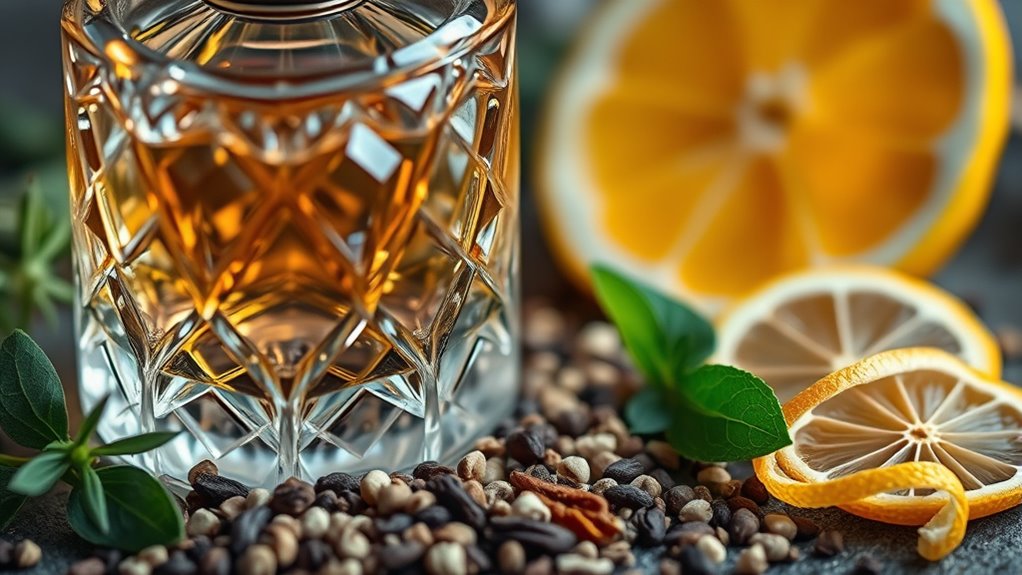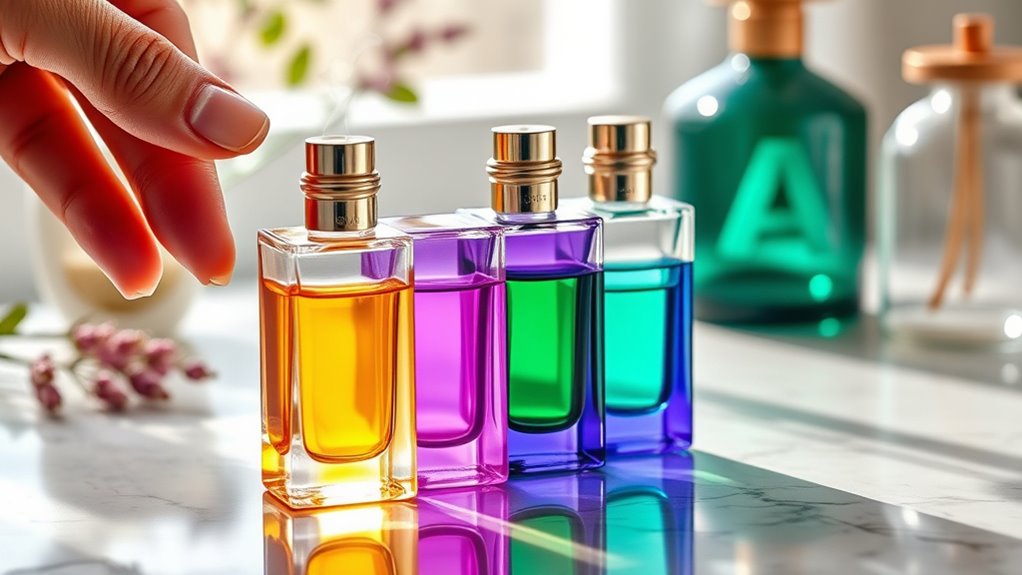To craft a signature fragrance through scent layering, you need to understand the components like top, middle, and base notes. Chemistry plays a key role in how these scents blend, interact, and last on your skin. Your emotional response and personal memories influence your choices, while techniques like balancing and harmonizing notes create a cohesive aroma. As fragrance evolves over time, developing your unique scent signature becomes a creative journey—exploring these details will help you master the art.
Key Takeaways
- Understanding top, middle, and base notes helps create balanced, layered fragrances that evolve over time.
- Molecular interactions and scent synergy influence how notes blend and stay lasting on the skin.
- Personal chemistry and skin pH affect scent development, requiring tailored layering techniques.
- Selecting durable ingredients like musk or amber enhances fragrance longevity and cohesion.
- Experimenting with scent combinations and adjusting note concentrations crafts a unique, signature fragrance profile.
Understanding the Components of Fragrance

Understanding the components of fragrance is essential to mastering scent layering. Your sense of scent memory plays a key role in how you perceive and combine different notes. Fragrances evolve over time, revealing top, middle, and base notes that create a layered experience. Recognizing these elements helps you craft a balanced and harmonious scent profile. The top notes are your initial impression—bright and fleeting—while the middle notes develop after the top fades, adding complexity. Base notes linger, anchoring the fragrance with depth. By understanding how these components interact and change, you can predict how a scent will evolve on your skin. This knowledge allows you to layer fragrances intentionally, enhancing your signature scent with precision and confidence. Additionally, popular fragrance notes can influence the overall character and harmony of your layered scent.
The Role of Chemistry in Scent Layering

Your choice of scents depends on how their molecules interact and stay stable over time. Chemistry influences how fragrances blend and persist on your skin. Understanding these factors helps you create lasting, harmonious scent layers.
Molecular Interactions Matter
Molecular interactions play a crucial role in how scents layer and evolve over time. When you combine different fragrances, the way their molecules interact determines scent synergy, creating a harmonious blend or a discordant clash. These interactions influence how each note unfolds, amplifies, or diminishes, affecting the overall scent experience. Understanding the chemistry behind molecular interactions helps you predict how layers will develop, ensuring your signature fragrance remains balanced and intriguing. Small molecular differences can lead to significant changes in scent behavior, so selecting notes that complement each other on a molecular level is key. Recognizing how molecular structures influence scent behavior allows perfumers to craft more cohesive and enthralling scent profiles that truly reflect your personal style.
Fragrance Stability Factors
Chemistry plays an essential role in determining how long a fragrance lasts and how well it maintains its intended scent profile over time. Factors like volatile compounds influence scent evaporation, affecting fragrance longevity. When certain molecules evaporate quickly, the scent fades faster; others linger longer. Understanding these stability factors helps you craft layered scents that remain appealing. Additionally, AI-driven analytics can assist in predicting how fragrances will perform under different conditions.
Chemistry and Personal Scent
Understanding how personal chemistry interacts with fragrances can substantially influence the way scents layer and evolve on your skin. Your body’s unique chemistry affects how synthetic aromas develop, making some notes more prominent while others fade faster. This dynamic leads to scent adaptation, where initial impressions change over time as your skin interacts with the fragrance. Factors like pH levels, skin oils, and temperature can amplify or diminish specific notes, so a scent that smells perfect on someone else may react differently on you. Recognizing this, you can tailor your scent layering to suit your chemistry, choosing combinations that enhance your natural scent profile. Additionally, awareness of individual scent development can help you select fragrances that harmonize with your unique body chemistry, allowing for more personalized and enduring scent experiences. Ultimately, understanding this chemistry allows you to craft a more personalized and harmonious signature fragrance.
Psychological Impact of Fragrance Combinations

Have you ever noticed how certain fragrance pairings can instantly boost your mood or evoke specific memories? That’s because scents create powerful emotional associations, acting as memory triggers deep within your mind. When you layer complementary fragrances, you reinforce these emotional responses, making you feel more confident, relaxed, or uplifted. For example, a citrus blend might energize you, while floral notes can evoke feelings of calm or nostalgia. These psychological effects happen because your brain links scents to past experiences or emotions, shaping how you feel in the moment. Additionally, understanding the Pimple Patch technology behind scent layering can help you choose fragrances that work synergistically for a more impactful experience. By understanding how fragrance combinations influence your mood and memories, you can craft a signature scent that not only smells good but also resonates emotionally, leaving a lasting impression on yourself and others.
Techniques for Harmonizing Different Notes

To create a balanced scent, start by pairing top and base notes thoughtfully, ensuring they complement each other without overpowering. Layer scents that work well together to enhance harmony and depth, and always consider how long each note lasts. Adjust your layering techniques to improve longevity and maintain a cohesive fragrance experience. Additionally, understanding the color accuracy of your fragrance can help you fine-tune the nuances for a more precise and satisfying scent profile.
Balancing Top and Base
Balancing top and base notes is essential for creating a harmonious fragrance that evolves beautifully over time. When you achieve this equilibrium, the scent perception remains engaging without feeling overwhelming or dull. A well-crafted harmony helps your fragrance develop smoothly, enhancing its fragrance memory and leaving a lasting impression. To do this, consider the following techniques:
- Adjust the concentration of notes to prevent overpowering top notes from overshadowing the base.
- Use middles notes as a bridge to soften progression between the initial burst and lingering depth.
- Test your scent over time to guarantee the top notes fade gracefully into the base, maintaining overall harmony.
- Understanding fragrance development can help you better anticipate how different notes will interact over the lifespan of your scent.
Layering Complementary Scents
Ever wondered how to create a fragrance that feels seamlessly unified? Layering complementary scents is the key. Start by selecting seasonal scent combinations—light citrus and floral notes work well in spring, while richer spices suit winter. Think about cultural fragrance influences, too; for example, pairing warm amber with exotic spices can evoke Middle Eastern traditions. To harmonize different notes, focus on balance: combine scents that share common undertones or contrasting elements that complement each other. Use the principle of harmony by blending scents that enhance one another, avoiding clashing or overpowering aromas. Remember, subtlety is essential—less is often more. By thoughtfully layering complementary scents, you craft a fragrance that feels natural, refined, and uniquely yours. When designing your signature scent, consider best colognes for men to understand which fragrances have proven harmonious and appealing.
Adjusting for Longevity
Adjusting for longevity guarantees your fragrance remains harmonious from first spritz to last. To manage scent intensity and extend wear time, consider layering techniques that balance your notes. Use a lightweight, scent-free moisturizer or a matching base scent to help boost longevity without overpowering. Applying slightly more of the base notes can anchor lighter top and middle notes, creating a cohesive scent profile. You might also choose more durable ingredients for your base layer, like musk or amber, to sustain the overall aroma longer.
- Apply base notes strategically to boost wear time and scent intensity
- Use moisturizers to enhance longevity without altering the fragrance’s harmony
- Adjust the amount of each layer based on desired scent strength and duration
The Evolution of Fragrance Over Time

The way fragrances have changed over time reveals much about cultural shifts and technological advancements. Throughout history, fragrance has served as a form of scent symbolism, conveying social status, spirituality, or personal identity. The fragrance history shows how societies valued different notes and ingredients, from ancient perfumes made with natural oils to modern synthetic creations. As technology evolved, so did the ability to craft complex scents, allowing for more nuanced and long-lasting fragrances. Cultural preferences also shifted, influencing which aromas gained popularity. Today, you can explore a rich tapestry of scent layers that reflect both tradition and innovation. Understanding this evolution helps you appreciate how fragrances tell stories—about history, identity, and technological progress—shaping your own scent journey.
Tips for Developing Your Personal Scent Signature

Creating a personal scent signature involves more than just choosing a favorite fragrance; it requires deliberate layering and selecting notes that resonate with your personality. To develop your unique scent, consider how scents evoke your scent memory and reflect your cultural influences. Your scent should feel authentic and memorable, leaving a lasting impression. Experiment with different combinations, starting with a base note that grounds you, then adding middle and top notes that express your personality. Pay attention to how the scent evolves over time, ensuring it aligns with your identity. Incorporating insights from data privacy concerns can help you understand the importance of maintaining your personal boundaries, even in your fragrance choices.
Creating a personal scent signature reflects your personality and cultural influences, leaving a lasting, authentic impression.
- Explore scents linked to your cultural background
- Use scent memory to identify what feels meaningful
- Balance notes to create harmony and uniqueness
Frequently Asked Questions
How Do Climate and Environment Influence Scent Layering Choices?
Climate and environment greatly influence your scent layering choices. Seasonal variations, like warmer summers or cold winters, determine whether you opt for lighter, fresh scents or richer, spicier ones. Environmental factors such as humidity, pollution, or dry air also affect how fragrances project and last on your skin. By considering these elements, you can craft a signature fragrance that complements your surroundings and adapts to your lifestyle.
Can Scent Layering Be Customized for Different Occasions or Moods?
Absolutely, you can customize scent layering for different occasions or moods. By adjusting for seasonal variations, you choose lighter, fresher scents for daytime or warmer, richer notes for evenings. Consider emotional expressions—bright citrus for happiness, soothing florals for relaxation. You actively blend your fragrances to match your vibe, making each scent experience uniquely personal. This flexibility lets you create a signature scent that evolves with your mood and the moment.
What Are Common Mistakes to Avoid When Creating a Signature Fragrance?
You might think creating a signature fragrance is straightforward, but avoid misjudging scent strength and neglecting skin chemistry. Too strong, and it overwhelms; too faint, and it vanishes. Overlooking how your skin interacts with scents can result in an aroma that doesn’t quite match your intent. To craft a balanced signature scent, test fragrances on your skin, start subtle, and adjust accordingly to ensure it’s uniquely yours without overpowering.
How Long Does It Typically Take to Develop a Personalized Scent Profile?
When it comes to fragrance development and scent profiling, creating your personalized scent profile usually takes a few weeks to a couple of months. You’ll work closely with a perfumer, trying different blends and notes to find what resonates with you. This process involves trial and error, so patience is key. Ultimately, it’s about refining your scent until it perfectly captures your personality and style.
Are There Any Health Considerations or Allergies Associated With Scent Layering?
When you layer scents, it’s important to consider allergy triggers and skin sensitivities. Some ingredients may cause allergic reactions or irritation, especially if you have sensitive skin. Always do a patch test first and check ingredient lists. If you notice redness, itching, or discomfort, stop using the scent. Consulting a dermatologist can help identify potential allergy triggers and ensure your scent layering remains safe and enjoyable.
Conclusion
By experimenting with different notes and understanding how they interact, you can craft a truly unique scent signature. For example, imagine layering warm vanilla with a hint of citrus—creating a lively yet comforting aroma. As you refine your combinations, you’ll discover what resonates with your personality and mood. Remember, scent layering is a personal journey, so trust your instincts and enjoy the process of creating a fragrance that’s uniquely yours.









